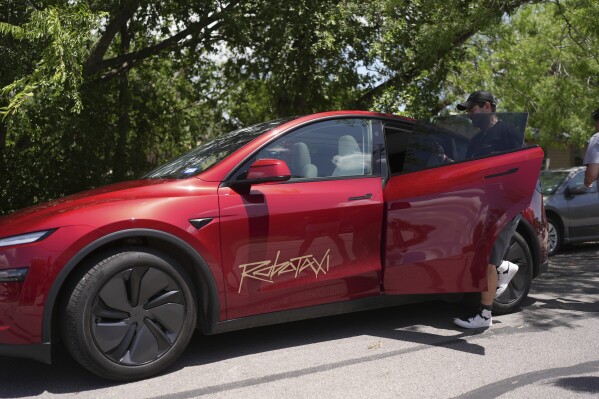Tesla has officially launched its long-anticipated robotaxi service, with a small pilot fleet taking to the streets of Austin, Texas on Sunday. The initial rollout featured a limited number of Tesla vehicles—distinctly marked with a “robotaxi” logo—providing paid rides to a select group of invited analysts, influencers, and shareholders.
While the pilot marks a significant step for Tesla, it was a relatively low-key affair. According to reports, each vehicle included a human safety operator in the passenger seat to monitor operations and intervene if necessary. Tesla has not yet deployed its futuristic Cybercab, the driverless concept car unveiled at the company’s We, Robot event in October. Instead, modified versions of existing Tesla models were used.
Tesla CEO Elon Musk praised the company’s AI and chip design teams on X, calling the rollout the “culmination of a decade of hard work.” He noted that both the AI chip and software teams were built entirely in-house. Musk also jokingly posted ahead of the launch that robotaxi rides would be priced at a “$4.20 flat fee.”
According to Forrester analyst Paul Miller, the launch underscores Tesla’s ambition to challenge established self-driving taxi providers in the US and China. “As expected, only a handful of vehicles are available right now, they only operate in a small part of the city, and there’s a safety driver in the vehicle,” he said. Still, the pilot demonstrates Tesla’s intent to compete in a rapidly evolving market.
Major players like Waymo (Alphabet-owned) and Zoox (an Amazon subsidiary) are already offering autonomous taxi services in several U.S. cities including Austin, San Francisco, and Phoenix. Uber, meanwhile, is expanding driverless trials internationally, partnering with Chinese firms Pony.AI, WeRide, and Momenta.
Tesla’s strategy hinges on its vast data network, mass vehicle deployment, and a lower-cost, camera-based self-driving system, which it believes will give it a long-term edge. However, that system—known as Full Self-Driving (FSD)—remains under scrutiny. U.S. regulators continue to investigate FSD-related safety concerns, while some Tesla users have voiced complaints about its reliability.
“If the current FSD offering isn’t a major leap forward from Tesla’s existing driver-assistance tech,” Miller added, “it will likely require extensive remote monitoring and backup from human teleoperators—driving up costs and increasing the risk of public missteps.”
In a post on Monday, Tesla asserted that its robotaxi service “will greatly increase safety for vulnerable road users, such as pedestrians & cyclists.” But the U.S. National Highway Traffic Safety Administration (NHTSA) is reviewing Tesla’s safety data, particularly regarding vehicle performance in adverse weather.
Tesla’s rollout comes at a time of heightened competition in the autonomous mobility space. German automaker Volkswagen recently estimated the global driverless taxi market could reach €450 billion by 2035. However, recent setbacks—such as General Motors’ decision to suspend its Cruise robotaxi service following a series of accidents—highlight the operational and regulatory challenges facing the sector.
As Tesla begins testing its robotaxis in public, all eyes will be on how its Full Self-Driving technology performs in real-world conditions—and whether it can safely scale in an increasingly crowded and scrutinized market.


